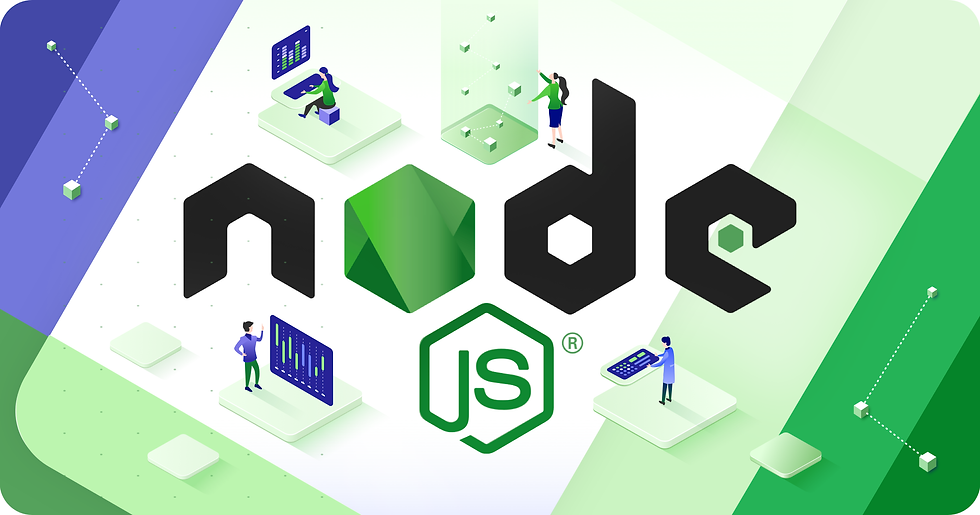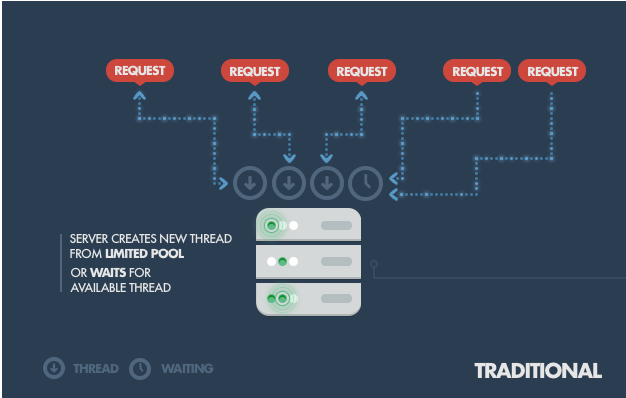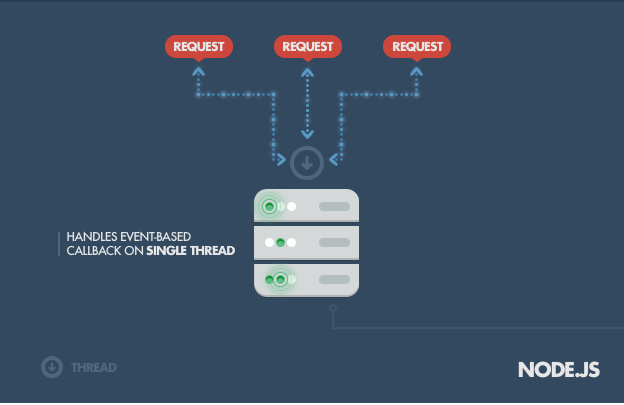Why use Node.js?
- Security Unleashed

- Apr 1, 2019
- 7 min read
Updated: Apr 14, 2019

JavaScript’s rising popularity has brought with it a lot of changes, and the face of web development today is dramatically different. The things that we can do on the web nowadays with JavaScript running on the server, as well as in the browser, were hard to imagine just several years ago, or were encapsulated within sandboxed environments like Flash or Java Applets.
As Wikipedia states: “Node.js is a packaged compilation of Google’s V8 JavaScript engine, the libuv platform abstraction layer, and a core library, which is itself primarily written in JavaScript.” Beyond that, it’s worth noting that Ryan Dahl, the creator of Node.js, was aiming to create real-time websites with push capability, “inspired by applications like Gmail”. In Node.js, he gave developers a tool for working in the non-blocking, event-driven I/O paradigm.
After over 20 years of stateless-web based on the stateless request-response paradigm, we finally have web applications with real-time, two-way connections.
In one sentence: Node.js shines in real-time web applications employing push technology over websockets. What is so revolutionary about that? Well, after over 20 years of stateless-web based on the stateless request-response paradigm, we finally have web applications with real-time, two-way connections, where both the client and server can initiate communication, allowing them to exchange data freely. This is in stark contrast to the typical web response paradigm, where the client always initiates communication. Additionally, it’s all based on the open web stack (HTML, CSS and JS) running over the standard port 80.
One might argue that we’ve had this for years in the form of Flash and Java Applets—but in reality, those were just sandboxed environments using the web as a transport protocol to be delivered to the client. Plus, they were run in isolation and often operated over non-standard ports, which may have required extra permissions and such.
How Does It Work?
The main idea of Node.js: use non-blocking, event-driven I/O to remain lightweight and efficient in the face of data-intensive real-time applications that run across distributed devices.
That’s a mouthful.
What it really means is that Node.js is not a silver-bullet new platform that will dominate the web development world. Instead, it’s a platform that fills a particular need.
What it really means is that Node.js is not a silver-bullet new platform that will dominate the web development world. Instead, it’s a platform that fills a particular need. And understanding this is absolutely essential. You definitely don’t want to use Node.js for CPU-intensive operations; in fact, using it for heavy computation will annul nearly all of its advantages. Where Node really shines is in building fast, scalable network applications, as it’s capable of handling a huge number of simultaneous connections with high throughput, which equates to high scalability.
How it works under-the-hood is pretty interesting. Compared to traditional web-serving techniques where each connection (request) spawns a new thread, taking up system RAM and eventually maxing-out at the amount of RAM available, Node.js operates on a single-thread, using non-blocking I/O calls, allowing it to support tens of thousands of concurrent connections held in the event loop.


A quick calculation: assuming that each thread potentially has an accompanying 2 MB of memory with it, running on a system with 8 GB of RAM puts us at a theoretical maximum of 4,000 concurrent connections (calculations taken from Michael Abernethy’s article “Just what is Node.js?”, published on IBM developerWorks in 2011; unfortunately, the article is not available anymore), plus the cost of context-switching between threads. That’s the scenario you typically deal with in traditional web-serving techniques. By avoiding all that, Node.js achieves scalability levels of over 1M concurrent connections, and over 600k concurrent websockets connections.
There is, of course, the question of sharing a single thread between all clients requests, and it is a potential pitfall of writing Node.js applications. Firstly, heavy computation could choke up Node’s single thread and cause problems for all clients (more on this later) as incoming requests would be blocked until said computation was completed. Secondly, developers need to be really careful not to allow an exception bubbling up to the core (topmost) Node.js event loop, which will cause the Node.js instance to terminate (effectively crashing the program).
The technique used to avoid exceptions bubbling up to the surface is passing errors back to the caller as callback parameters (instead of throwing them, like in other environments). Even if some unhandled exception manages to bubble up, tools have been developed to monitor the Node.js process and perform the necessary recovery of a crashed instance (although you probably won’t be able to recover the current state of the user session), the most common being the Forever module, or using a different approach with external system tools upstart and monit, or even just upstart.
NPM: The Node Package Manager
When discussing Node.js, one thing that definitely should not be omitted is built-in support for package management using NPM, a tool that comes by default with every Node.js installation. The idea of NPM modules is quite similar to that of Ruby Gems: a set of publicly available, reusable components, available through easy installation via an online repository, with version and dependency management.
A full list of packaged modules can be found on the npm website, or accessed using the npm CLI tool that automatically gets installed with Node.js. The module ecosystem is open to all, and anyone can publish their own module that will be listed in the npm repository.
Some of the most useful npm modules today are:
· express - Express.js—or simply Express—a Sinatra-inspired web development framework for Node.js, and the de-facto standard for the majority of Node.js applications out there today.
· hapi - a very modular and simple to use configuration-centric framework for building web and services applications
· connect - Connect is an extensible HTTP server framework for Node.js, providing a collection of high performance “plugins” known as middleware; serves as a base foundation for Express.
· socket.io and sockjs - Server-side component of the two most common websockets components out there today.
· pug (formerly Jade) - One of the popular templating engines, inspired by HAML, a default in Express.js.
· mongodb and mongojs - MongoDB wrappers to provide the API for MongoDB object databases in Node.js.
· redis - Redis client library.
· lodash (underscore, lazy.js) - The JavaScript utility belt. Underscore initiated the game, but got overthrown by one of its two counterparts, mainly due to better performance and modular implementation.
· forever - Probably the most common utility for ensuring that a given node script runs continuously. Keeps your Node.js process up in production in the face of any unexpected failures.
· bluebird - A full featured Promises/A+ implementation with exceptionally good performance
· moment - A JavaScript date library for parsing, validating, manipulating, and formatting dates.
The list goes on. There are tons of really useful packages out there, available to all (no offense to those that I’ve omitted here).
Where Node.js Can Be Used
SERVER-SIDE WEB APPLICATIONS
Node.js with Express.js can also be used to create classic web applications on the server-side. However, while possible, this request-response paradigm in which Node.js would be carrying around rendered HTML is not the most typical use-case. There are arguments to be made for and against this approach. Here are some facts to consider:
Pros:
If your application doesn’t have any CPU intensive computation, you can build it in Javascript top-to-bottom, even down to the database level if you use JSON storage Object DB like MongoDB. This eases development (including hiring) significantly.Crawlers receive a fully-rendered HTML response, which is far more SEO-friendly than, say, a Single Page Application or a websockets app run on top of Node.js.
Cons:
Any CPU intensive computation will block Node.js responsiveness, so a threaded platform is a better approach. Alternatively, you could try scaling out the computation [*].Using Node.js with a relational database is still quite a pain (see below for more detail). Do yourself a favour and pick up any other environment like Rails, Django, or ASP.Net MVC if you’re trying to perform relational operations.[*] An alternative to these CPU intensive computations is to create a highly scalable MQ-backed environment with back-end processing to keep Node as a front-facing ‘clerk’ to handle client requests asynchronously.
Where Node.js Shouldn’t Be Used
SERVER-SIDE WEB APPLICATION W/ A RELATIONAL DB BEHIND
Comparing Node.js with Express.js against Ruby on Rails, for example, there used to be a clean decision in favor of the latter when it came to accessing relational databases like PostgreSQL, MySQL, and Microsoft SQL Server.
Relational DB tools for Node.js were still in their early stages. On the other hand, Rails automatically provides data access setup right out of the box together with DB schema migrations support tools and other Gems (pun intended). Rails and its peer frameworks have mature and proven Active Record or Data Mapper data access layer implementations.[*]
But things have changed. Sequelize, TypeORM, and Bookshelf have gone a long way towards becoming mature ORM solutions. It might also be worth checking out Join Monster if you’re looking to generate SQL from GraphQL queries.
HEAVY SERVER-SIDE COMPUTATION/PROCESSING
When it comes to heavy computation, Node.js is not the best platform around. No, you definitely don’t want to build a Fibonacci computation server in Node.js. In general, any CPU intensive operation annuls all the throughput benefits Node offers with its event-driven, non-blocking I/O model because any incoming requests will be blocked while the thread is occupied with your number-crunching—assuming you’re trying to run your computations in the same Node instance you’re responding to requests with.
As stated previously, Node.js is single-threaded and uses only a single CPU core. When it comes to adding concurrency on a multi-core server, there is some work being done by the Node core team in the form of a cluster module [ref: http://nodejs.org/api/cluster.html]. You can also run several Node.js server instances pretty easily behind a reverse proxy via nginx.
With clustering, you should still offload all heavy computation to background processes written in a more appropriate environment for that, and having them communicate via a message queue server like RabbitMQ.
Even though your background processing might be run on the same server initially, such an approach has the potential for very high scalability. Those background processing services could be easily distributed out to separate worker servers without the need to configure the loads of front-facing web servers.
Of course, you’d use the same approach on other platforms too, but with Node.js you get that high reqs/sec throughput we’ve talked about, as each request is a small task handled very quickly and efficiently.




Comments